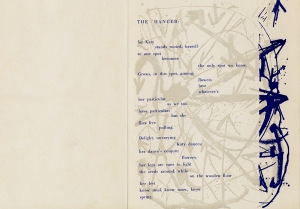
‘The Dancer’, 1951, poem by Joel Oppenheimer, drawing by Robert Rauschenberg, printed at Black Mountain College by Oppenheimer and Jonathan Williams, Jargon 2.
Found among the literary broadside collection in Archives and Special Collections are works that represent unique, unusual and innovative collaborations between poets and artists. Poetry broadsides produced between the 1950s and early 1970s offer some of the most diverse examples of poem and picture combinations. Visual artists, printmakers, typesetters, and graphic artists emerging from American schools and cities experimented with forms and techniques influenced by their association with other artists, writers, and performers.
Black Mountain College in the 1950s is often described by those that attended and taught there as a laboratory for artistic collaboration. The print shop at the small college in the foothills of North Carolina’s Blue Ridge Mountains was a space where experimentation and collaboration were encouraged, producing small-run editions of poetry and poetry broadsides alongside the works of print-makers and visual artists. Joel Oppenheimer partnered with the painter Robert Rauschenberg, both students at the time, and the poet and emerging small-press publisher Jonathan Williams, to create ‘The Dancer’.
Join us in celebration of the exhibition ‘Poem and Picture’ at the Benton Museum at the University of Connecticut featuring ‘The Dancer’ (“The Dancer”, 1951, poem by Joel Oppenheimer, drawing by Robert Rauschenberg, printed at Black Mountain College by Oppenheimer and Jonathan Williams, Jargon 2), and National Poetry Month.

My late wife and I were pleased to meet JW, with whom I’d corresponded for some years, years ago here in Santa Fe. I’ve known about the earliest Jargon publications from Black Mtn., but have only his own “Red/Grey.” Oppenheimer was a great writer, and- as I’ve heard (EG: JW)- a fine man. I’m glad that “The Dancer” is part of your exhibit! As some of us know, Jargon was quintessentially American (Given JW, how could it have been otherwise?)
Keep up such fine shows!
I am a lover of the arts; poetry, art, dance. I found out about broadsides back in the early 80’s and have went broadside crazy. I mostly use artwork by Romare Bearden, but it is very interesting how this form is really making a comeback sort-of-speak. Thank you for this site now I can send people who don’t understand what it is that i am talking about when i refer to broadsides.